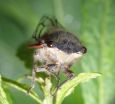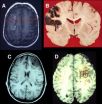(Press-News.org) Organisms in a symbiotic relationship will often shed genes as they come to rely on the other organism for crucial functions. But now researchers have uncovered an unusual event in which a bacterium that lives in a type of cicada split into two species, doubling the number of organisms required for the symbiosis to survive.
Cicadas of the genus Tettigades feed only on sap they suck out of plants. To create some of the essential amino acids they rely on two bacterial helpers — Candidatus Hodgkinia cicadicola and Candidatus Sulcia muelleri — with which they have lived in symbiosis for millions of years.
At one time Tettigades cicadas and Hodgkinia might have been able to survive without each other, but as they evolved together, the bacterium shed genes that it no longer needed, leaving it with a very small genome of 169 genes in total.
CIFAR Associate John McCutcheon's lab at the University of Montana was sequencing the genome of species within this cicada when PhD student James Van Leuven discovered that at some point about 5 million years ago, one of the bacteria, Hodgkinia, had split into two separate species, both of which are now required by the cicadas. Their findings will appear online at Cell Aug. 28.
While the extra symbiont seems to make little functional difference to the cicadas' life, it leaves the insect reliant on double the species to create the same nutrients that only one could make before. The researchers argue the genetic split was non-adaptive, meaning it happened because of chance and had no clear benefit to the organism.
"For the insect, it is probably easier to deal with two symbionts than it is three," McCutcheon says.
The case appears to be one of the clearest examples researchers have found yet of non-adaptive evolution, although selection still plays a role in maintaining the original gene set. The research illustrates the complex factors that drive and refine the evolution of all life, from insects to organelles such as mitochondria, which are tied closely to human disease.
"It may be a window into these sorts of fundamental processes," McCutcheon says.
McCutcheon says his involvement with CIFAR's program in Integrated Microbial Biodiversity and discussions with other CIFAR fellows had a major influence on this research.
"Without my involvement in CIFAR, this paper would either be dull or it wouldn't exist," he says.
"Members of the Integrated Microbial Biodiversity program have made me think hard about my work and about how it fits into the larger evolutionary picture."
INFORMATION:
About CIFAR
CIFAR creates knowledge that will transform our world. The Institute brings together outstanding researchers to work in global networks that address some of the most important questions our world faces today. Our networks help support the growth of research leaders and are catalysts for change in business, government and society.
Established in 1982, CIFAR is a Canadian-based, global organization, comprised of nearly 350 fellows, scholars and advisors from more than 100 institutions in 16 countries. CIFAR partners with the Government of Canada, provincial governments, individuals, foundations, corporations and research institutions to extend our impact in the world.
CIFAR's Integrated Microbial Biodiversity program explores the diverse microbial world that surrounds and permeates human life. Fellows are transforming human understanding of biodiversity, and changing approaches to medicine and health, environmental sustainability and evolutionary biology itself.
Contacts:
Lindsay Jolivet
Writer & Media Relations Specialist
Canadian Institute for Advanced Research
lindsay.jolivet@cifar.ca
(416) 971-4871
John McCutcheon
CIFAR Associate
University of Montana
john.mccutcheon@umontana.edu
(406) 243-6071
Non-adaptive evolution in a cicada's gut
2014-08-28
ELSE PRESS RELEASES FROM THIS DATE:
How studying damage to the prefrontal lobe has helped unlock the brain's mysteries
2014-08-28
Until the last few decades, the frontal lobes of the brain were shrouded in mystery and erroneously thought of as nonessential for normal function—hence the frequent use of lobotomies in the early 20th century to treat psychiatric disorders. Now a review publishing August 28 in the Cell Press journal Neuron highlights groundbreaking studies of patients with brain damage that reveal how distinct areas of the frontal lobes are critical for a person's ability to learn, multitask, control their emotions, socialize, and make real-life decisions. The findings have helped experts ...
Circulating tumor cell clusters more likely to cause metastasis than single cells
2014-08-28
Circulating tumor cell (CTC) clusters – clumps of from 2 to 50 tumor cells that break off a primary tumor and are carried through the bloodstream – appear to be much more likely to cause metastasis than are single CTCs, according to a study from investigators at the Massachusetts General Hospital (MGH) Cancer Center. Their report in the August 28 issue of Cell also suggests that a cell adhesion protein binding CTC clusters together is a potential therapeutic target.
"While CTCs are considered to be precursors of metastasis, the significance of CTC clusters, which are ...
NYU researchers ID process producing neuronal diversity in fruit flies' visual system
2014-08-28
New York University biologists have identified a mechanism that helps explain how the diversity of neurons that make up the visual system is generated.
"Our research uncovers a process that dictates both timing and cell survival in order to engender the heterogeneity of neurons used for vision," explains NYU Biology Professor Claude Desplan, the study's senior author.
The study's other co-authors were: Claire Bertet, Xin Li, Ted Erclik, Matthieu Cavey, and Brent Wells—all postdoctoral fellows at NYU.
Their work, which appears in the latest issue of the journal Cell, ...
Zombie bacteria are nothing to be afraid of
2014-08-28
VIDEO:
Heidi Arjes of Washington University in St. Louis explains how the failsafes in the bacterial cell cycle work. A bacterium that fails to pass either failsafe enters a zombified state...
Click here for more information.
A cell is not a soap bubble that can simply pinch in two to reproduce. The ability to faithfully copy genetic material and distribute it equally to daughter cells is fundamental to all forms of life. Even seemingly simple single-celled organisms must have ...
Research shows how premalignant cells can sense oncogenesis and halt growth
2014-08-28
Cold Spring Harbor, NY -- What happens inside cells when they detect the activation of a cancer-inducing gene? Sometimes, cells are able to signal internally to stop the cell cycle. Such cells are able to enter, at least for a time, a protective non-growth state.
Since the 1980s, scientists have known that mutations in a human gene called RAS are capable of setting cells on a path to cancer. Today, a team at Cold Spring Harbor Laboratory (CSHL) publishes experiments showing how cells can respond to an activated RAS gene by entering a quiescent state, called senescence.
CSHL ...
Computer games give a boost to English
2014-08-28
If you want to make a mark in the world of computer games you had better have a good English vocabulary. It has now also been scientifically proven that someone who is good at computer games has a larger English vocabulary. This is revealed by a study at the University of Gothenburg and Karlstad University, Sweden.
The study confirms what many parents and teachers already suspected: young people who play a lot of interactive English computer games gain an advantage in terms of their English vocabulary compared with those who do not play or only play a little.
The study ...
NASA's TRMM satellite adds up Cristobal's heavy rainfall in the Caribbean
2014-08-28
The Caribbean Islands of Turks and Caicos were drenched from Tropical Storm Cristobal before the storm moved north and intensified into a hurricane. NASA's TRMM satellite added up the rainfall and revealed the soaking those islands received.
The Tropical Rainfall Measuring Mission or TRMM satellite is like a flying rain gauge in space. It can estimate rainfall throughout storms on Earth from its orbit around the planet. TRMM is managed by both NASA and the Japan Aerospace Exploration Agency known as JAXA and has been in orbit since 1997 covering the tropics.
At NASA's ...
Study finds marine protected areas inadequate for protecting fish and ocean ecology
2014-08-28
A new study reports that an expansion of marine protected areas is needed to protect fish species that perform key ecological functions. According to investigators from the Wildlife Conservation Society and other organizations, previous efforts at protecting fish have focused on saving the largest numbers of species, often at the expense of those species that provide key and difficult-to-replace ecological functions.
Many vital ecological functions of ocean ecology are performed by fish species that also are food for millions of people. This study uncovers a significant ...
NASA's TRMM analyzes Hurricane Cristobal
2014-08-28
VIDEO:
TRMM satellite passed over Cristobal on Aug. 27 at 8:16 a.m. EDT. Cristobal didn't appear round and symmetric in either clouds or rainfall which suggests that the hurricane is being...
Click here for more information.
NASA's Tropical Rainfall Measuring Mission or TRMM Satellite provided a look under the hood of Hurricane Cristobal as it continues moving north and paralleling the U.S. East Coast. NASA's HS3 hurricane mission also investigated the storm. Cristobal is now ...
A new, tunable device for spintronics
2014-08-28
Spin-charge converters are important devices in spintronics, an electronic which is not only based on the charge of electrons but also on their spin and the spin-related magnetism. Spin-charge converters enable the transformation of electric into magnetic signals and vice versa. Recently, the research group of Professor Jairo Sinova from the Institute of Physics at Johannes Gutenberg University Mainz in collaboration with researchers from the UK, Prague, and Japan, has for the first time realised a new, efficient spin-charge converter based on the common semiconductor material ...







